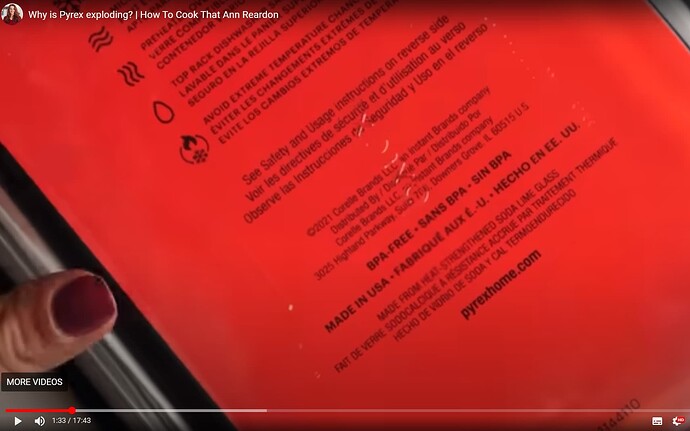I think you have to read the packaging to know or lacking the package identify the product you have and look up what it was made from. To be fair it is rare for products to be marked with details of their material content.
You could be right - it could be on the packaging. Although considering that, treated well, it lasts for ages and often gets passed on to family or donated to op shops and the like. I think it needs to be moulded into the products.
It may further consumer understanding (or add to the confusion) to point put PYREX, pyrex are trade marked brands. Hence the previous posters’ advice to look beyond the brand name. Unfortunately with glassware there are limits to the information which can be included on the finished product. The original packaging and care instructions are the most reliable source of information.
There are multiple brands of borosilicate glass cookware and nearly as many different trade marks to describe the product. Availability in Australia of other brands can be somewhat limited.
A sample of what might be available:
OXO brand - borosilicate glassware,
Or
Bodum branded glassware.
‘Bodum
If it is it needs to be other than a brand trademark. Brands these days have a history of changing owner. Where the product is manufactured and the standards applied can differ.
For other types of products for which safety is important there are recognised standards and identification marks. Some products can carry the marks and standards symbols for a lifetime. Some cannot, in which instance the original packaging is all that one has to rely on.
That was what I was referring. The Pyrex products we have don’t have much, if any, information on them. The only one which has some information is a glass jug set which has country of manufacture (US in this case).
It would be useful to have glass type on the products themselves, especially if their recommended use is different.
BTW, with any glass in the kitchen we refrain from sudden temperature changes such as from the freezer to a hot oven, irrespective of the glass type. Most are used in the microwave, and ocassionally borosilicate glass dish in the oven for a dessert or lasagna. These are at about room temp from preparation when placed in the oven.
Inrerestingly, she says at about 1m34s “it doesnt mention anywhere on the label what kind of glass it’s made from” when referring to the product made in the USA …
… except where her example says “MADE FROM HEAT STRENGTHENED SODA LIME GLASS”
… or if one prefers the French version “FAIT DE VERRE SODOCALCIQUE A RESISTANCE ACCRUE PAR TRAITEMENT THERMIQUE” which roughly Google translates to “MADE OF SODA-LIME GLASS WITH INCREASED RESISTANCE BY HEAT TREATMENT”
… or in Spanish “HECHO DE VIDRIO DE SODA Y CAL TERMOENDURECIDO” which roughly Google translates to “MADE OF THERMOSETTING SODA-LIME GLASS”
Any typo’s mine, any translate issues Google ![]()
Screenshots from the youtube video …
Some pics I took a while back and posted earlier in this thread here …

